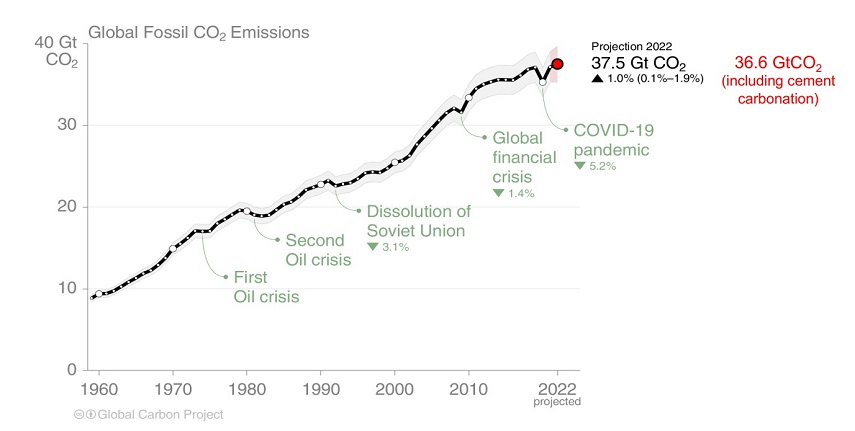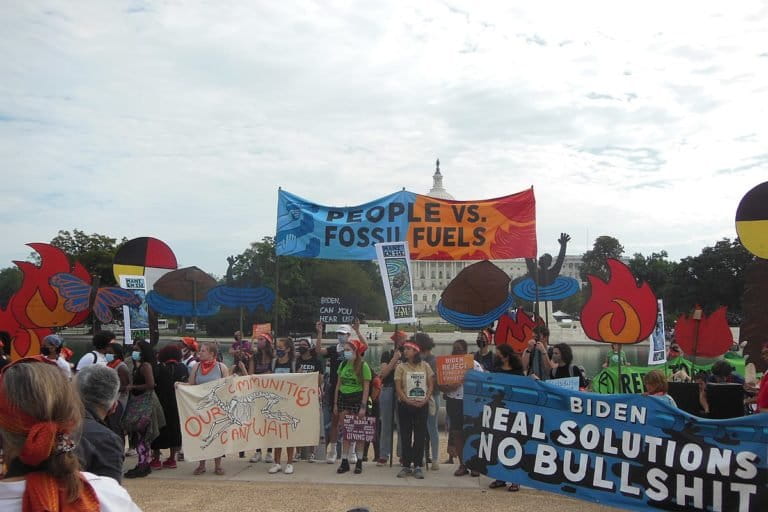- After a brief slowdown during the COVID-19 pandemic, carbon dioxide emissions from fossil fuel have rapidly increased and could reach a record level in 2022, says a report.
- China and the European Union are experiencing a decline in total fossil carbon dioxide emissions while the USA and India’s carbon emissions are increasing.
- The turmoil in the energy market is visible in the emission pattern as well. The emission from natural gas use is declining but it is increasing with coal consumption.
After a brief pause during COVID-19-related lockdowns, global carbon emission levels have been rising again. Carbon dioxide emissions from fossil fuels in 2022 are estimated to reach a record level, reducing the chance of limiting global warming under 1.5 degrees Celsius, as committed under the Paris Agreement, indicates a report released by international research project, Global Carbon Project (GCP), in Sharm el-Sheikh, where global leaders are meeting for the UN climate conference, COP27, to deliberate on climate change. According to the GCP report, India has the largest contribution to the global growth of fossil CO2 emissions in 2022.
“Total global CO2 emissions are projected to be 40.6 billion tonnes (GtCO2) in 2022,” says the Global Carbon Budget report, a research publication developed by an international team of more than 100 scientists, facilitated by the GCP. The report says fossil CO2 emissions continued to increase by 1.0% in 2022, compared to 2021.
The fossil CO2 emissions this year are now slightly above the 2019, pre-COVID-19 level. In 2019, the global fossil CO2 emissions were at their peak (36.4 GtCO2). It is estimated to reach 36.6 Gt CO2 in 2022, says the report.
Released in the first week of November, the report says that global fossil CO2 emissions were 5.1% higher in 2021 than in 2020. This was when the world was rebounding from the worst of the COVID-19 pandemic.
The world has a limited carbon budget, which is the amount of carbon emissions that can be released into the atmosphere without any significant change in the planet’s temperature. If this amount exhausted, which means if carbon emissions cross this budget, a rise in the planet’s temperature is almost certain. For a 50% likelihood to limit global warming to 1.5°C, the remaining carbon budget has been reduced to 380 GtCO2.
With the current pace of emissions, however, the budget will be exhausted in nine years.
At the beginning of 2020, the global carbon budget to restrict warming to 1.5 degrees Celsius, was 500 GtCO2, according to the Assessment Report (AR-6) of the Intergovernmental Panel on Climate Change (IPCC) 2021. The AR-6 report explained that every 1000 GtCO2 of cumulative carbon emission is likely to cause “a 0.27°C to 0.63°C increase in global surface temperature with the best estimate of 0.45°C.” From 1850 to 2019, a total of 2390 GtCO2 of anthropogenic CO2 was emitted, informs the report.

Based on this nearly linear relationship between cumulative CO2 emissions and increases in global surface temperature, scientists estimate how past and future CO2 emissions affect global surface temperature.
Polluters trend
In 2022, as economies hit by the COVID-19 pandemic are recovering and the Russia-Ukraine war has changed energy consumption patterns, there has been an impact on emissions as well.
The Global Carbon Budget report says that the 2022 projections of major emitters is mixed – emissions are projected to fall in China (0.9%) and the EU (0.8%) and increase in the USA (1.5%) and India (6%), with a 1.7% rise in the rest of the world combined.
Emissions are reducing in China, which contributed 31.6% of global fossil CO2 emissions in 2021. This reduction is largely attributed to continued lockdowns that have constrained economic activity and growth. The report says that the largest contribution to the total emissions decrease comes from the drop in cement emissions resulting from the slowdown in property development.
“Fossil CO2 emissions in China will almost certainly go down this year,” said Jan Ivar Korsbakken, a senior researcher at the Centre for International Climate Research (CICERO), in an article on the Global Carbon Project’s annual analysis of trends in the global carbon cycle. “COVID lockdowns, a collapse in the construction sector and economic headwinds have constrained energy consumption growth this year,” he was quoted as saying in the article.
Emissions in the European Union (EU) are also projected to decrease by 0.8%. The European Union comprises 27 countries that together contribute to 7.7% of global fossil CO2 emissions. It is the most affected region by the energy crisis driven by Russia and the Ukraine war.
The Carbon Project analysis says that the fossil CO2 emissions reduction in the EU is driven largely by the reduced emissions from natural gas, following the recent disruption in the natural gas supply. The emission from natural gas is estimated to decline by about 10% for the year. Though emissions from coal are projected to increase by 6.7% and oil to increase by 0.9%, the total emissions from these two sources is less than the drop in natural gas emissions.

Compared to China and the EU which are seeing a drop in emissions, India, the United States and the rest of the world together are significant contributors to CO2 emissions in 2022.
This analysis also says that the United States of America contributed 13.8% of global fossil CO2 emissions in 2021 and in 2022, its emission is projected to increase by 1.5%. The report gives details of the trend by saying that emissions from natural gas are projected to rise by 4.7% and those from coal to decline by 4.6% in the U.S. From the consumption of oil products, emissions are projected to increase by 2%, and credit goes to the continued rebound of domestic aviation after the pandemic.
The report also finds that India has the largest contribution to growth in fossil CO2 emissions in 2022. “Indian fossil CO2 emissions have grown at over 3% per year in the last 10 years and now exceed emissions in the European Union, but India’s per capita emissions are still only a third of those in the EU,” said Robbie Andrew, a senior researcher at CICERO, a Norway-based leading climate research institute.
When asked about the difference between developed and developing countries in emission patterns, Pep Canadell, Executive Director of Global Carbon Project says, “The biggest difference is that many OECD countries are now on a CO2 emission decline trend. There are some 24 countries that over the last 10 years have had emissions declining, while still a growing economy. As a bloc, of course, we are talking about 100-plus countries. So, we need to be honest, of course, the biggest individual countries that push emissions, for instance, are the U.S. and India. But of course, if we put 50 or 60 less-developing countries in a block, then they also contribute quite a bit. It is a very unfair comparison.”
When asked about India’s possible options to reduce emissions as the country that has already set an ambitious target of energy transition and is still being considered a major polluter, Pep Canadell told Mongabay-India that India, coming from such a low base energy per capita, will continue to grow over the coming many decades. And that is why the country’s net zero emission target is very far. “I think there is not really an alternative there other than really accelerating the renewable energy transition. In many others, renewable economics can take over very quickly. Large projects are being put in place. It is not that anyone is losing money there. But these are real opportunities. So, there is no other way around, other than really accelerating this transition,” he added.
Turmoil in energy markets visible in emission growth
According to experts, the various fossil fuels are being impacted differently by the unrest in the world energy markets. Although CO2 emissions from the use of natural gas have increased steadily at a rate of 2.2% annually over the past ten years, they are predicted to modestly fall in 2022 by 0.2%, possibly marking just the third such decline since 1990. Other reductions took place in 2009 and 2020.

On the other hand, CO2 emissions from the use of coal are anticipated to increase 1.0%, possibly surpassing the previous high in 2014. Although coal use globally has plateaued over the past ten years, it is still unclear when it will begin to fall, the report says.
The GCP analysis predicts a 2.2% increase in CO2 emissions from oil use. The rise in international aviation is the main cause of this expansion which is still below 2019 levels and yet making a recovery after the pandemic shock.
“Given that a further recovery in oil use is expected in 2023 if coal or gas use remains flat or increases, then it is likely that global fossil CO2 emissions will continue to rise in 2023 without a concerted policy effort,” said Robbie Andrew.
Banner image: A thermal power plant in Ukraine. In 2022, as economies hit by the COVID-19 pandemic are recovering and the Russia-Ukraine war has changed energy consumption patterns, there has been an impact on emissions as well. Photo by Oleg Savitsky/Wikimedia commons
